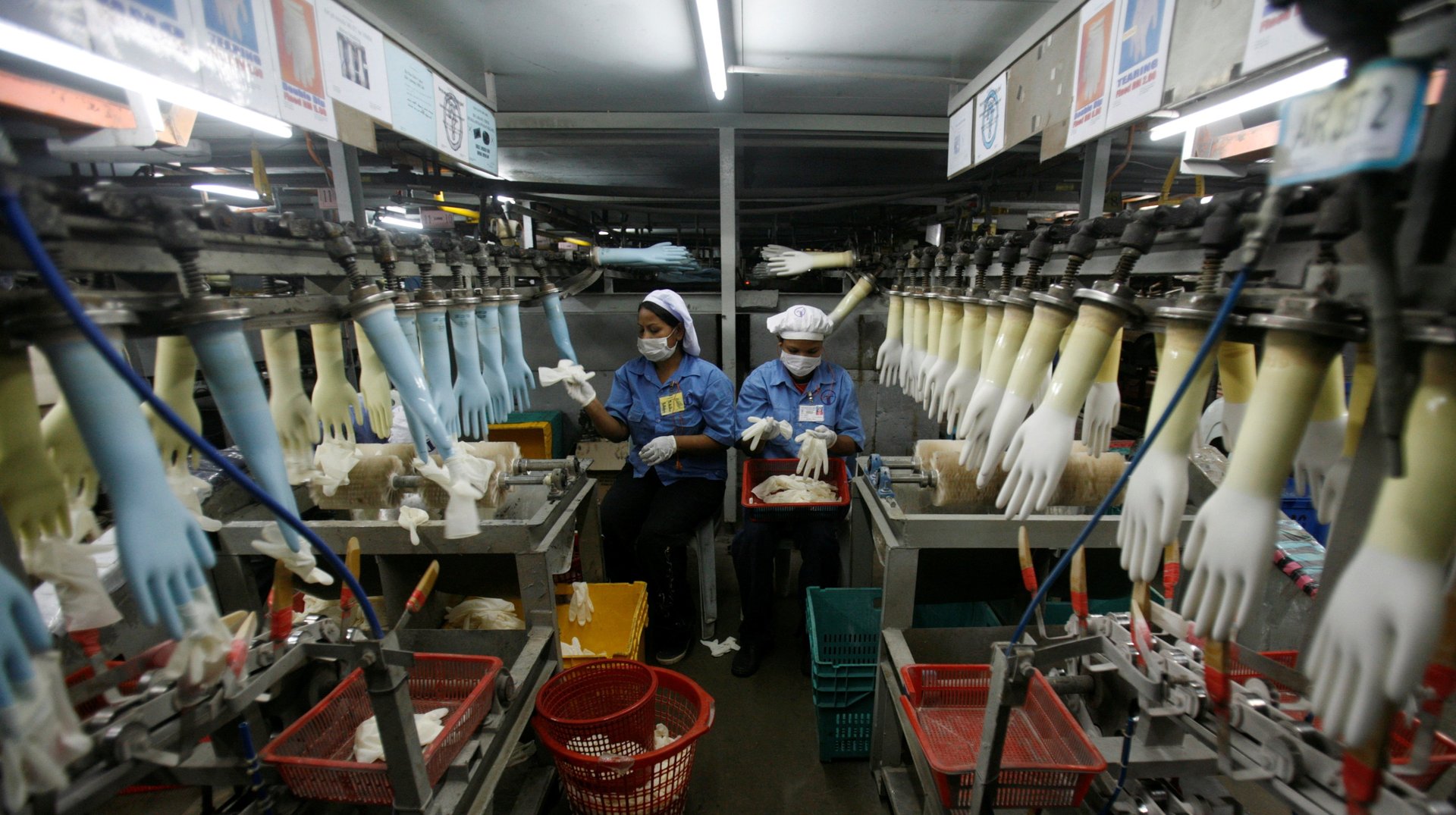A monopoly explains why rubber gloves prices are up in the US
In 2020, hospitals were short on everything and willing to pay astronomical prices for PPE. But dramatic early-pandemic tales of cutthroat procurement for medical supplies are mostly behind us, with one outlier.


In 2020, hospitals were short on everything and willing to pay astronomical prices for PPE. But dramatic early-pandemic tales of cutthroat procurement for medical supplies are mostly behind us, with one outlier.
Despite an explosive surge in global demand that has seen 10.4 billion covid vaccine doses administered so far, the price of syringes have remained unchanged for more than a decade, hovering between 7 and 8 cents each, according to US Census Bureau data released last month.
Save for a brief spike in prices in January 2022 for N95 and KN95 masks at the height of the omicron wave, N95 mask prices have decreased almost 5-fold between 2020 and 2021, from $1.52 to 32 cents per unit. Disposable masks have dropped from 14 cents a piece, to 4 cents.
Meanwhile, the annual average price of medical gloves imported into the US soared from 56 cents for a dozen pairs in 2019 (or under 5 cents for a single pair), to $1.77 in 2021. The price increases, combined with higher demand, saw the value of rubber glove imports to the US in 2021 reach $7 billion in 2021, up from $2.3 billion in 2020.
Spiking demand, spiking prices
By January 2021, a survey by Premier, a US healthcare group procurement organization with a membership of more than 4,000 hospitals and health systems, found that procuring exam gloves was second only to staffing issues as the biggest challenge in caring for covid patients.
An April 2021 Premier report noted that global demand exceeded production capacity by 215 billion units, with glove demand increasing 40% since covid vaccinations started. In the US alone, fully vaccinating the entire population creates demand for about 660 million gloves, according to a June 2021 analysis of glove prices by a researcher at the US International Trade Commission.
In addition to health workers, rubber gloves are being used by previously bare-handed grocery clerks, gig work shoppers, and delivery workers.
Supply constraints for rubber gloves
Most of the world’s rubber glove supply is produced in Southeast Asia, where raw materials for nitrile gloves and natural rubber are in close proximity. Top Glove, a Malaysia-based company, is the world’s largest producer of nitrile gloves, a synthetic rubber compound, and natural rubber latex gloves.
In 2020, as factories in the US and elsewhere turned to making N95, surgical, and cloth masks to fill the pandemic demand, access to raw materials for rubber gloves remained limited. There were shortages in the materials for nitrile gloves—butadiene and acrylonitrile— as well as the ceramic hands to mold them, making starting up new rubber glove factories to expand global production capacity difficult.
Then, in July 2020, the US banned rubber glove imports from Top Glove due to reasonable though not conclusive evidence of forced labor—”debt bondage, excessive overtime, abusive working and living conditions, and retention of identity documents,” according to a statement by Customs and Border Patrol. In November 2020, Top Glove was also ordered by the Malaysian government to shut down many of its factories for several weeks after a widespread covid outbreak among workers living in cramped conditions.
The import ban was only lifted in September 2021. Top Glove, at its annual meeting last month, said that North America accounted for 15% of its 2021 sales volume, compared to 22% in 2020 on account of the ban.
Is the boom ending for the world’s top glove manufacturers?
As an article by Forbes points out, the increase in prices for acrylonitrile and butadiene, the chemicals used for nitrile rubber, doubled between March and December 2020, while glove prices went up as much as tenfold in the first year of the pandemic, minting new glove tycoons in Malaysia and Thailand.
From June to August 2020, Top Glove posted a 1,646% surge in profits, to over $300 million. In its financial year that ended in August 2021, revenues hit an all-time high of $3.9 billion (16.4 billion Malaysian ringgit), a 126% increase from the previous year. The net profit from its 2021 financial year exceeded the company’s profits of the past 20 years combined, and allowed for a more than 400% increase in dividends to shareholders.
However, the boom times may already be fading. In December, the company noted that the price of raw materials for nitrile and latex gloves are falling, while competition from new players in China and elsewhere could also bring glove prices—and profits—down this year.